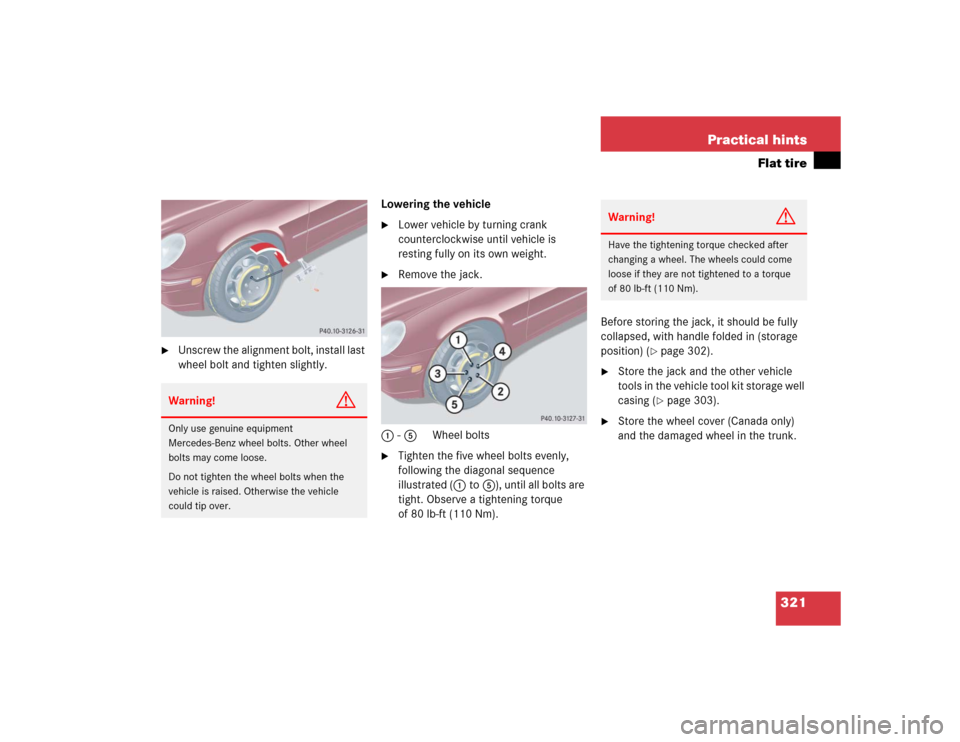Page 262 of 400

262 OperationTires and wheelsTire pressure changes by approx. 1.5 psi
(0.1 bar) per 18°F (10°C) of air tempera-
ture change. Keep this in mind when
checking tire pressure where the tempera-
ture is different from the outside tempera-
ture.
Tire temperature and tire pressure are also
increased while driving, depending on the
driving speed and the tire load.
Check the spare tire periodically for condi-
tion and inflation. Spare tires will age and
become worn over time even if never used,
and thus should be inspected and replaced
when necessary.
Rotating wheels
On vehicles with the same wheel size all
around, wheels can be rotated every 3 000
to 6 000 miles (5 000 to 10 000 km), or
sooner if necessary, according to the
degree of tire wear. The same direction of
tire rotation must be retained.Rotate the wheels before the characteris-
tic tire wear pattern becomes visible
(shoulder wear on front wheels and tread
center wear on rear wheels).
Thoroughly clean the inner side of the
wheels after each rotation. Check and
ensure proper tire inflation pressure.
Warning!
G
Follow recommended inflation pressures.
Do not overinflate tires. Overinflated tires
can result in sudden deflation (blowout)
because they are more likely to become
punctured or damaged by road debris,
potholes, etc.
Do not underinflate tires. Underinflated tires
wear unevenly, adversely affect handling
and fuel economy, and are more likely to fail
from being overheated.
Do not overload the tires by exceeding the
specified vehicle capacity weight (as indi-
cated by the label on the pillar in the driver’s
door opening). Overloading the tires can
overheat them, possibly causing a blowout.Warning!
G
Rotate front and rear wheels only if they are
of the same size.
Warning!
G
Have the tightening torque checked after
changing a wheel. Wheels could become
loose if not tightened with a torque of
80 lb-ft (110 Nm).
Only use genuine Mercedes-Benz wheel
bolts specified for your vehicle's rims.
Page 321 of 400

321 Practical hints
Flat tire
�
Unscrew the alignment bolt, install last
wheel bolt and tighten slightly.Lowering the vehicle
�
Lower vehicle by turning crank
counterclockwise until vehicle is
resting fully on its own weight.
�
Remove the jack.
1 - 5Wheel bolts
�
Tighten the five wheel bolts evenly,
following the diagonal sequence
illustrated (1to5), until all bolts are
tight. Observe a tightening torque
of 80 lb-ft (110 Nm).Before storing the jack, it should be fully
collapsed, with handle folded in (storage
position) (
�page 302).
�
Store the jack and the other vehicle
tools in the vehicle tool kit storage well
casing (
�page 303).
�
Store the wheel cover (Canada only)
and the damaged wheel in the trunk.
Warning!
G
Only use genuine equipment
Mercedes-Benz wheel bolts. Other wheel
bolts may come loose.
Do not tighten the wheel bolts when the
vehicle is raised. Otherwise the vehicle
could tip over.
Warning!
G
Have the tightening torque checked after
changing a wheel. The wheels could come
loose if they are not tightened to a torque
of 80 lb-ft (110 Nm).
Page 340 of 400
340 Technical dataEngine
�EngineModel
C 230 Kompressor Sport (203.040)
1
1The quoted data apply only to the standard vehicle. See an authorized Mercedes-Benz Center for the corresponding data of all special bodies and special equipment.
C 240 (203.061)
1
C 240 4MATIC (203.081)
1
Engine
271
112
Mode of operation
4-stroke engine, gasoline injection
4-stroke engine, gasoline injection
No. of cylinders
4
6
Bore
3.23 in (82.00 mm)
3.54 in (89.90 mm)
Stroke
3.35 in (85.00 mm)
2.68 in (68.20 mm)
Total piston displacement
109.6 cu in (1 796 cm
3)
158.5 cu in (2 597 cm
3)
Compression ratio
8.5:1
10.5:1
Output acc. to SAE J 1349
189 hp/5 800 rpm
(141 kW/5 800 rpm)
168 hp/5 500 rpm
(125 kW/5 500 rpm)
Maximum torque acc. to SAE J 1349
192 lb-ft/3 500 - 4 000 rpm
(260 Nm/3 500 - 4 000 rpm)
177 lb-ft/4 500 rpm
(240 Nm/4 500 rpm)
Maximum engine speed
6000 rpm
6200 rpm
Firing order
1-3-4-2
1-4-3-6-2-5
Poly-V-belt
2420 mm
2380 mm
Page 341 of 400
341 Technical data
Engine
Model
C 320 (203.064)
1
C 320 4MATIC (203.084)
1
C 320 Sport (203.064)
1
C32AMG(203.065)
1
Engine
112
112
Mode of operation
4-stroke engine, gasoline injection
4-stroke engine, gasoline injection
No. of cylinders
6
6
Bore
3.54 in (89.90 mm)
3.54 in (89.90 mm)
Stroke
3.31 in (84.00 mm)
3.31 in (84.00 mm)
Total piston displacement
195.2 cu in (3 199 cm
3)
195.2 cu in (3 199 cm
3)
Compression ratio
10:1
9:1
Output acc. to SAE J 1349
215 hp/5 700 rpm
(160 kW/5 700 rpm)
349 hp/6 100 rpm
(260 kW/6 100 rpm)
Maximum torque acc. to SAE J 1349
229 lb-ft/3 000 - 4 600 rpm
(310 Nm/3 000 - 4 600 rpm)
332 lb-ft/4 400 rpm
(450 Nm/4 400 rpm)
Maximum engine speed
6000 rpm
6 200 rpm
Firing order
1-4-3-6-2-5
1-4-3-6-2-5
Poly-V-belt
2380 mm
2 908 mm
1The quoted data apply only to the standard vehicle. See an authorized Mercedes-Benz Center for the corresponding data of all special bodies and special equipment.
Page 346 of 400
346 Technical dataElectrical system
�Electrical systemModel
C230KompressorSport
C 240/C 320 (all models)
C32AMG
Generator (alternator)
14 V/120 A
14 V/120 A
14 V/120 A
Starter motor
12 V/1.1 kW
12 V/1.7 kW
12 V/1.7 kW
Battery
12 V/100 Ah
12 V/100 Ah
12 V/100 Ah
Spark plugs
Bosch F 6 MPP 332
Bosch F 8 DPP 332
NGK PFR 5 R-11
NGK IFR 6 D 10
Electrode gap
0.031 in (0.8 mm)
0.039 in (1.0 mm)
0.039 in (1.0 mm)
Tightening torque
18–22lb-ft (25–30Nm)
15–22lb-ft (20–30Nm)
15 – 22 lb-ft (20 – 30 Nm)
Page 364 of 400

364 Technical termsPower train
Collective term designating all
components used to generate and
transmit motive power to the drive
axles, including
�
engine
�
clutch/torque converter
�
transmission
�
transfer case
�
drive shaft
�
differential
�
axle shafts/axles
Program mode selector switch
Used to switch the automatic trans-
mission between standard operationS
and comfort operationC.Remote Vehicle Diagnostics
Transmission of vehicle data and
current location to the Mercedes-Benz
Customer Assistance Center for
subscribers to Tele Aid service.
REST
(Residual engine heat utilization)
Feature that uses the engine heat
stored in the coolant to heat the
vehicle interior for a short time after
the engine has been turned off.
Restraint systems
Seat belts, belt tensioners, airbags and
child restraint systems. As inde-
pendent systems, their protective
functions complement one another.RON
(R
esearch O
ctane N
umber)
The Research Octane Number for gaso-
line as determined by a standardized
method. It is an indication of a gaso-
line's ability to resist undesired deto-
nation (knocking). The average of both
the ->MON (Motor Octane Number)
and RON (Research Octane Number) is
posted at the pump, also known as
ANTI-KNOCK INDEX.
Shift lock
When the vehicle is parked, this lock
prevents the transmission gear
selector lever from being moved out of
positionP without SmartKey turned
and brake pedal depressed.
SRS
(S
upplemental R
estraint S
ystem)
Seat belts, emergency tensioning
device and airbags. Though indepen-
dent systems, they are closely inter-
faced to provide effective occupant
protection.
Page 365 of 400

365 Technical terms
Tele Aid* System
(T
elematic A
larm I
dentification on
D
emand)
The Tele Aid system consists of three
types of response: automatic and
manual emergency, roadside assis-
tance and information. Tele Aid is
initially activated by completing a
subscriber agreement and placing an
acquaintance call.
The Tele Aid system is operational
provided that the vehicle’s battery is
charged, properly connected, not
damaged and cellular and GPS
coverage is available.Telematics*
A combination of the terms “tele-
communications” and “informatics”.
Tightening torque
Force times lever arm (e.g. a lug
wrench) with which threaded fasteners
such as wheel bolts are tightened.
Tire speed rating
Part of tire designation; indicates the
speed range for which a tire is
approved.Traction
Force exerted by the vehicle on the
road via the tires.
VIN
(V
ehicle I
dentification N
umber)
The number set by the manufacturer
and placed on the body to uniquely
identify each vehicle produced.
Voice control system*
Voice control system for car phones,
portable cell phones and audio
systems (radio, CD, etc.).
Page 393 of 400

393 Index
Technical data
Air conditioning refrigerant 352
Brake fluid 352
Coolant 350
Coolants 356
Electrical system 346
Engine oil additives 352
Engine oils 352
Flexible fuel vehicles 354
Fuel requirements 353
Fuels 350
Gasoline additives 354
Lubricants 349
Main dimensions 347
Premium unleaded gasoline 353
Rims and tires 342
Weights 348
Windshield washer 351
Windshield washer and headlamp
cleaning* system 351, 358Tele Aid* 223
Emergency calls 224
Information 227
Initiating an emergency call
manually 226
Message in display 299
Remote door unlock 230
Roadside assistance 226
SOS button 226
Stolen vehicle tracking services 230
System self-check 224
Tele Aid System 223, 365
Upgrade signals 229
Telematics* 365
Telephone* 24, 222
Answering a call 139
Dialing a number from
the phone book 140
Emergency call 198
Ending a call 139
Hands-free microphone 27Loading phone book 140
Message in display 299
Operation 138, 193
Redialing 140
Signal strength 139
Temperature
Display mode 127
Grades of tires 360
Setting interior temperature
Automatic climate control* 165
Climate control 156
Setting units in display 127
Tires 262
Tightening torque
(Wheel bolts) 321, 365
Tilt
Head restraint
Manual seat 34
Power seat* 36
Time
Setting hours 126
Setting minutes 126